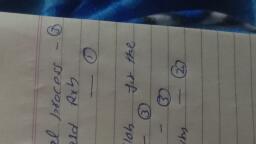Question 2 :
What is the work done when 1 mole of a gas expands isothermally from 25 L to 250 L at a constant pressure of 1 atm and a temperature of 300 K?
Question 3 :
The heat of neutralisation of {tex} \mathrm { HCl } {/tex} by {tex} \mathrm { NaOH } {/tex} is {tex} - 55.9 {/tex} {tex} \mathrm { kJmol } ^ { - 1 } {/tex} . If the heat of neutralisation of HCN by NaOH is {tex} - 12.1 \mathrm { kJ } / \mathrm { mol } , {/tex} the energy of dissociation of {tex} \mathrm { HCN } {/tex} is<br>
Question 4 :
The internal energy change when a system goes from state A to B is {tex} 40 \mathrm { kJ } / \mathrm { mole } {/tex} . If the system goes from A to B by a reversible path and returns to state A by an irreversible path what would be the net change in internal energy?
Question 5 :
What is the change in internal energy {tex} \Delta \mathrm U , {/tex} for a system that does {tex}70 \mathrm { J } {/tex} of work as it absorbs {tex}45 \mathrm { J } {/tex} of heat?
Question 6 :
Assuming that water vapour is an ideal gas, the internal energy change {tex} ( \Delta \mathrm { U } ) {/tex} when 1 mol of water is vapourised at 1 bar pressure and {tex} 100 ^ { \circ } \mathrm { C } {/tex} , (given : molar enthalpy of vapourisation of water at 1 bar and {tex} 373 \mathrm { K } = 41 \ \mathrm { kJ } \mathrm { mol } ^ { - 1 } {/tex} and {tex} \mathrm { R } = 8.3 \ \mathrm { J } \mathrm { mol } ^ { - 1 } \mathrm { K } ^ { - 1 } {/tex}) will be
Question 8 :
The heats of neutralisation of four acids {tex} A , B , C , D {/tex} are {tex} - 13.7 , - 9.4 , - 11.2 {/tex} and {tex} - 12.4 {/tex} kcal respectively when they are neutralised by a common base. The acidic character obeys which of the following order?<br>
Question 9 :
If the internal energy of an ideal gas decreases by the same amount as the work done by the system, the process is
Question 10 :
Which of the following is not true about H<sub>2</sub>O molecule ?
Question 11 :
For the reaction shown, which is closest to the value of {tex} \Delta \mathrm { H } ? {/tex}<br>{tex} 2 \mathrm { Cr } ^ { + 3 } ( \mathrm { aq } ) + 3 \mathrm { Ni } ( \mathrm { s } ) \rightarrow 2 \mathrm { Cr } ( \mathrm { s } ) + 3 \mathrm { Ni } ^ { + 2 } ( \mathrm { aq } ) {/tex}<br>{tex} \Delta H _ { f } ^ { 0 } {/tex} of {tex} \mathrm { Cr } _ { ( \mathrm { aq } ) } ^ { + 3 } {/tex} and {tex} \mathrm { Ni } _ { ( \mathrm { aq } ) } ^ { + 2 } {/tex} are {tex} - 143 {/tex} and {tex} - 54 \mathrm { kJ } / \mathrm { mol } {/tex}
Question 12 :
Warming ammonium chloride with sodium hydroxide in a test tube is an example of :
Question 13 :
If, {tex} \mathrm { H } _ { 2 } ( \mathrm { g } ) + \mathrm { Cl } _ { 2 } ( \mathrm { g } ) \rightarrow 2 \mathrm { HCl } ; \Delta \mathrm H ^ { \circ } = - 44 \mathrm { kcal } {/tex}<br> {tex} 2 \mathrm { Na } ( \mathrm { s } ) + 2 \mathrm { HCl } ( \mathrm { g } ) \rightarrow 2 \mathrm { NaCl } ( \mathrm { s } ) + \mathrm { H } _ { 2 } ( \mathrm { g } ) {/tex}<br>{tex} \mathrm{\triangle H=-152 \,kcal}{/tex}<br>then, {tex} \Delta \mathrm { H } {/tex} for {tex} 2 \mathrm { Na } + \mathrm { Cl } _ { 2 } \longrightarrow 2 \mathrm { NaCl } {/tex} is<br>
Question 14 :
At constant temperature and pressure which one of the following statements is correct for the reaction?<br>{tex} \mathrm { CO } ( \mathrm { g } ) + 1 / 2 \mathrm { O } _ { 2 } ( \mathrm { g } ) \longrightarrow \mathrm { CO } _ { 2 } ( \mathrm { g } ) {/tex}<br>
Question 15 :
The enthalpy of neutralization of 40.0 g of NaOH by 60.0 g of CH<sub>3</sub>COOH will be :
Question 16 :
A system changes from state X to Y with a change in internal energy measuring to 25 kJ <img style='object-fit:contain' src='https://storage.googleapis.com/teachmint/question_assets/JEE%20Main/5e798580c6cb6261b35b2dad' height='21' width='37' >, by a reversible path and returns from Y to X by an irreversible path. What will be the net change in internal energy?
Question 17 :
A piston filled with 0.04 mol of an ideal gas expands reversibly from {tex}50.0 \mathrm { mL } {/tex} to {tex}375 \mathrm { mL } {/tex} at a constant temperature of {tex} 37.0 ^ { \circ } \mathrm { C } {/tex} . As it does so, it absorbs {tex}208 \mathrm { J } {/tex} of heat. The values of {tex} \mathrm { q } {/tex} and {tex} \mathrm { w } {/tex} for the process will be: {tex} ( \mathrm { R } = 8.314 \mathrm { J } / \mathrm { mol } \mathrm { K } ) ( \ln 7.5 = 2.01 ) {/tex}
Question 18 :
For a monatomic gas, the value of the ratio of {tex} \mathrm { C } _ { \mathrm { p } . \mathrm { m } } {/tex} and {tex} \mathrm { C } _ { \mathrm { v } . \mathrm { m } } {/tex} is
Question 19 :
If water vapour is assumed to be a perfect gas, molar enthalpy change for vapourisation of 1 mol of water at 1 bar and {tex} 100 ^ { \circ } \mathrm { C } {/tex} is 41{tex} \mathrm { kJ } {/tex} mol {tex} ^ { - 1 } {/tex}. Calculate the internal energy change, when 1 mol of water is vapourised at 1 bar pressure and {tex} 100 ^ { \circ } \mathrm { C } {/tex}
Question 20 :
If the bond dissociation energies of {tex} \mathrm { XY } , \mathrm { X } _ { 2 } {/tex} and {tex} \mathrm { Y } _ { 2 } {/tex} ( all diatomic molecules) are in the ratio of {tex} 1 : 1 : 0.5 {/tex} and {tex} \Delta \mathrm { H } _ { f } {/tex} for {tex} \mathrm { for } {/tex} the formation of {tex} \mathrm { XY } {/tex} is {tex} - 200 \mathrm { kJ } {/tex} mole {tex} ^ { - 1 } {/tex} . The bond dissociation energy of {tex} \mathrm { X } _ { 2 } {/tex} will be
Question 21 :
Molar heat capacity of water at constant pressure {tex} \mathrm P {/tex} is {tex} 75\mathrm { JK } ^ { - 1 } {/tex}. When {tex}1 \mathrm { kJ } {/tex} of heat is supplied to {tex}100 \mathrm { g } {/tex} of water which is free to expand, the increasing temperature of water is<br>
Question 22 :
The heat required to raise the temperature of body by 1 K is called
Question 23 :
What can be concluded from the given graph?<br><img style='object-fit:contain' src='https://storage.googleapis.com/teachmint/question_assets/JEE%20Main/5e798608adb2ea6185a769d2' height='198' width='247' >
Question 24 :
{tex} \begin{array} { l l } { \text { For the reactions, } } \\ { 2 \mathrm { C } + \mathrm { O } _ { 2 } \rightarrow 2 \mathrm { CO } _ { 2 } ; } & { \Delta \mathrm { H } = - 393 \mathrm { J } } \\ { 2 \mathrm { Zn } + \mathrm { O } _ { 2 } \rightarrow 2 \mathrm { ZnO } ; } & { \Delta \mathrm { H } = - 412 \mathrm { J } } \end{array} {/tex}
Question 25 :
The heat of combustion of sucrose, {tex} \left( \mathrm { C } _ { 12 } \mathrm { H } _ { 22 } \mathrm { O } _ { 11 } ( \mathrm { s } ) \right) {/tex} at constant volume is {tex} - 1348.9 \,\mathrm { kcal }\,\, \mathrm { mol } ^ { - 1 } {/tex} at {tex} 25 ^ { \circ } \mathrm { C } , {/tex} then the heat of reaction at constant pressure, when steam is produced, is<br>
Question 26 :
Given: {tex} \mathrm { N } _ { 2 } ( \mathrm { g } ) + 3 \mathrm { H } _ { 2 } ( \mathrm { g } ) \rightarrow 2 \mathrm { NH } _ { 3 } ( \mathrm { g } ) ; \Delta r H ^ { \circ } = - 92.4 \mathrm { kJ } {/tex} {tex} \mathrm { mol } ^ { - 1 } {/tex}<br>What is the standard enthalpy of formation of {tex} \mathrm { NH } _ { 3 } {/tex} gas?<br>
Question 27 :
An ideal gas expands in volume from {tex} 1 \times 10 ^ { - 3 } {/tex} to {tex} 1 \times 10 ^ { - 2 } \mathrm { m } ^ { 3 } {/tex} at {tex}300 \mathrm { K } {/tex} against a constant pressure of {tex} 1 \times 10 ^ { 5 } \mathrm { Nm } ^ { - 2 } {/tex} . The work done is
Question 28 :
The correct relationship between free energy change in a reaction and the corresponding equilibrium constant {tex} \mathrm { K } _ { \mathrm { c } } {/tex} is {tex} {/tex}











































